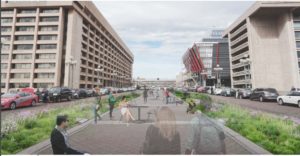
The improved 10th St., SW—south promenade, looking north; Photo: SWBID & Michael Vergason Landscape Architects, Ltd.

The improved 10th St., SW—north promenade, looking south; Photo: SWBID & Michael Vergason Landscape Architects, Ltd.
A quiet street rests amid the weaving maze of the on-ramps and off-ramps of 395. Linking the Washington Channel to the National Mall, 10th St., SW has long been a forgotten connector to the neighborhood. But all of that is about to change.
A partnership between the SWBID, JBG Smith and the International Spy Museum is seeking to reimagine not just the look and feel of the half-mile corridor, but its purpose as well. The new Spy Museum is set to open along this stretch in the spring of 2019, bringing many new visitors to the neighborhood. “The street walkways are wide and can be pedestrian friendly. By activating the boulevard and providing shade and canopy options, this currently barren street can blossom into its true potential: a beautiful, welcoming space that connects the National Mall to the Wharf, and is worthy of our Nation’s Capital,” says Aliza Bran, Public Relations and Marketing Coordinator for the Spy Museum.
The concept in the National Capital Planning Commission (NCPC) presentation lays out four major components: provide cooling shade, enrich experience, expand seating opportunities and create spatial moments. Landscape including canopy trees, native grasses and perennials are at the heart of this redesign. A major component of this plan is that none of the improvements are permanent. Each one is temporary and can easily be reversed. According to the presentation, also key for these improvements will be that they “build on the strongly metered pattern of I.M. Pei’s original design with the addition of trees, ground cover, and seasonal plantings over the existing concrete panels” for the northern half of the promenade, while to the south the plantings will “build on the recent perennial plantings on the slope of Benjamin Banneker Park.”
Benjamin Banneker Park, which in its current form serves as more of a traffic circle than a park, is named for the African-American astrologer and almanac author, who in 1791 assisted in the original survey for the District of Columbia. The 4.7-acre urban park is administered by the National Park Service (NPS) and was originally conceived in 1967 as “The Tenth Street Overlook.” The DC Council petitioned NPS to rename the park in honor of Banneker in 1970, only a year after construction was complete. During the 2000s, the site was the subject of many conversations of redevelopment including redevelopments such as a potential baseball stadium, the National Museum of African-American History and Culture, and the National Children’s Museum. All of the conversation around redevelopment led the DC Historical Preservation League to list the park as one of the most endangered places in the city. Most recently, the park has been included as a part of the SW Ecodistrict, (accepted by the NCPC in 2014), as well as receiving improvements through a staircase and enhanced lighting, further connecting the park to the Wharf, this past Spring.
The Banneker staircase was one of the first major components of renovating 10th St. The second component will involve the installation of planters, trees and furniture along L’Enfant Plaza, and the final component is the restoration of the fountain in Banneker Park, which when operating correctly is capable of shooting water over 30 feet in the air. The SWBID is prioritizing fixing the fountain, which could cost as much as $800,000. If successful, repairing the fountain would further drive visitors to walk the full stretch of 10th St., strengthening its foundation as a gathering place for the neighborhood.
Many are credited with helping revitalize this part of the neighborhood, including the commitments of time and resources from individuals at PN Hoffman, JBG, the Spy Museum, and the SWBID. Through a reimagined use of space, these partners hope to create a new destination for locals and visitors alike. By discovering the hidden gem that is 10th St. and Banneker Park, the public will change their perspective of the area. It will no longer serve as just a connector, but rather will serve as a terminus in itself—a quiet oasis amidst of the hustle and bustle of the new SW.
By Katelynd Mahoney Anderson

